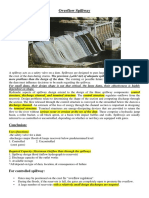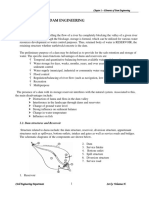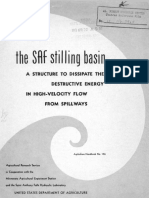Hydraulics of Rubber Dam Overflow: A Simple Design Approach
Hydraulics of Rubber Dam Overflow: A Simple Design Approach
Uploaded by
RazvanCopyright:
Available Formats
Hydraulics of Rubber Dam Overflow: A Simple Design Approach
Hydraulics of Rubber Dam Overflow: A Simple Design Approach
Uploaded by
RazvanOriginal Description:
Original Title
Copyright
Available Formats
Share this document
Did you find this document useful?
Is this content inappropriate?
Copyright:
Available Formats
Hydraulics of Rubber Dam Overflow: A Simple Design Approach
Hydraulics of Rubber Dam Overflow: A Simple Design Approach
Uploaded by
RazvanCopyright:
Available Formats
13th Australasian Fluid Mechanics Conference
Monash University, melbourne, Australia
13-18 December 1998
255
HYDRAULICS OF RUBBER DAM OVERFLOW : A SIMPLE DESIGN APPROACH
H. CHANSON
Department of Civil Engineering, The University of Queensland, Brisbane QLD 4072, AUSTRALIA
ABSTRACT
Rubber dams have been used for the past 40 years in river
and coastal engineering applications, in Australia and
overseas. Despite the increasing interest for rubber dams,
little information is available on their hydraulic
performances. The overflow characteristics of inflated rubber
dams are re-investigated. New analytical calculations provide
information on the wall pressure distribution and on the
nappe trajectory. The calculations are compared with over
160 new experiments. Altogether the results provide a new
method to predict overflow characteristics and new design
guidelines are derived for the optimum location of the
deflector.
INTRODUCTION
Rubber dams are long tubular-shaped fabrics placed across
channels, streams and weir crest to raise the upstream water
level when inflated (Fig. 1). In open channels, they are
commonly used to raise water levels, to increase water
storage and to prevent chemical dispersion (Table 1). The
interest in inflatable dams is increasing because of the ease of
placement. Such structures can be installed during later
development stages.
The membrane is usually deflated for large overflows. It is
however common practice to allow small spillages over the
inflated dam. During overflows, vibrations might result from
fluid-structure interactions (e.g. OGIHARA and
MARAMATSU 1985, WU and PLAUT 1996), and the
instabilities might damage and destroy the rubber membrane.
Several failures were experienced including in Australia. In
practice, a deflector (i.e. fin) is installed on the downstream
face of the rubber dam to project the nappe away from the
membrane, hence preventing rubber membrane vibrations
(Fig. 2).
Little attention has been paid on the overflow hydraulics.
ANWAR (1967) investigated experimentally small overflow.
Other studies (e.g. SHEPHERD et al. 1969, BINNIE et al.
1973) discussed the fluid-structure interactions of inflated
rubber dams.
In the present paper, the characteristics of rubber dam
overflow are re-investigated. New analytical calculations of
nappe trajectory are presented and the results are compared
with laboratory experiments. New guidelines for the
optimum design of rubber dam deflector are discussed.
NAPPE TRAJECTORY
Considering a fully-inflated rubber dam, the downstream
face of the dam follows closely the shape of a circular
cylinder as observed by ANWAR (1967). For the sake of
simplicity, we shall consider an idealised rubber dam shape
(Fig. 2).
Fig. 1: Sketch of a rubber dam
Year Site Characteristic
s
Manufactur
er
Remarks
(1) (2) (3) (4) (5)
1965 Koomboolo
omba dam,
QLD
L =1 60 m,
D =1.22 &
1.5 m, H
infl
=
0.91 m
Fabridam-
Firestone
No deflector. Water
filled. Placed on
ogee crest. Design
overflow : 2.4 m
2
/s
(inflated), 35 m
2
/s
(deflated).
1967 Proston
weir, QLD
L =1 51 m,
D =1.5 m,
H
infl
=1.4 m
Fabridam-
Firestone
No deflector. water
filled
1983 Val Bird
weir, North
QLD
L =2 82 m,
D =1.9 m,
H
infl
=0.5 m
Fabridam-
Firestone
Water filled.
1996 Lyell dam,
NSW
L =2 40 m,
D =3.5 m,
H
infl
=1.4 m
Bridgestone With deflector. Air
filled
1997 Dumbleton
weir,
Central
QLD
L =2 75 m,
D =2 m
H
infl
=0.7 m
Queensland
Rubber Co.
With deflector. Air
filled.
Table 1: Examples of rubber dams installed in Australia
256
Fig. 2: Rubber dam overflow
Downstream of the crest, the overflowing nappe adheres to
the weir face because the convex wall curvature imposes a
pressure field modification within the nappe inducing a
suction pressure. The resulting Coanda effect acts on the wall
surface in a direction normal to the flow direction.
At the crest, critical flow conditions occur. Downstream of
the crest, the flow depth and velocity derive from the
continuity and motion equations. Assuming an ideal-fluid
flow, it yields :
F = F
crest
2
+ 2 * (1 - cos) (1)
d
R
=
d
crest
R
3/2
*
C
D
k
3/2
*
1
F
(2)
where d is the flow depth, V is the velocity, F =V/ g*R, is
the angular position, F
crest
=V
crest
/ g*R, C
D
is the
discharge coefficient, H
1
is the upstream total head, D is the
dam height, d
crest
is the flow depth at the crest, R is the
radius of curvature and k = d
crest
/d
c
accounts for the
streamline curvature and non-uniform distributions of
pressure and velocity at the crest (Fig. 2).
At the surface of the rubber dam, the wall pressure may be
deduced from the motion equation in the radial direction. At
any position , the dimensionless pressure distribution at the
wall equals :
P
atm
- P
s
w
*g*R
=
d
R
*
F
2
- cos *
1 +
d
2*R
(3)
where P
s
is the absolute pressure at the wall, P
atm
is the
atmospheric pressure,
w
is the water density. Equation (3)
predicts an increasing suction pressure (P
atm
- P
s
) down the
rubber membrane as the flow is accelerated.
The nappe adherence on the wall might lead to flow
instability at the base of the nappe (i.e. next to the separation
position), pressure fluctuations on the downstream face of the
dam and vibrations of the flexible membrane. Nappe
adherence instabilities may be eliminated by deflecting the
nappe off the rubber wall (Fig. 2).
At take-off the flow properties (d
o
, V
o
,
o
) are deduced from
the Bernoulli and continuity equations, neglecting energy
losses and assuming that the effects of the developing
boundary layer are small (i.e. Eq. (1) and (2)). Usually the
deflected nappe angle
o
at take-off is smaller than the
deflector angle , and it may be estimated in first
approximation as :
= tanh
h
d
o
*
(4)
where h is the deflector height measured normal to the wall
and d
o
is the nappe thickness at take-off (Fig. 2).
The trajectory equations of a ventilated nappe are :
x
R
=
V
o
g*R
* cos(
def
-
o
) *
g * t
2
R
+
x
o
R
(5)
y
R
= -
1
2
*
g *t
2
R
-
V
o
g*R
* sin(
def
-
o
) *
g * t
2
R
+
y
o
R
(6)
where x is the horizontal direction, y is the vertical direction
positive upwards, t is the time, x
o
and y
o
are the co-ordinates
of the deflector edge,
def
is the angular position of the
deflector.
Equations (1) to (6) may be combined to predict the nappe
trajectory from the crest down to the nappe impact.
COMPARISON WITH EXPERIMENTAL DATA
Experimental setup
Laboratory experiments were conducted to validate
qualitatively and quantitatively the basic flow patterns. The
inflated rubber dams were idealised with circular concrete
cylinders (Fig. 3). Two rectangular channels were used. Each
flume is supplied with recirculating water supplied by a
constant head tank, the discharge being measured by 90-
degree V-notch weirs.
Several configurations were tested : i.e., three cylinder sizes
(R =0.052, 0.0755, 0.117 m), several deflector sizes and
positions (0 h 0.11 m, 0
def
90 deg.). All cylindrical
weirs had a smooth varnish surface and the deflected napped
were ventilated by sidewall splitters. The flow depths were
measured on the centreline using point gauges connected to a
Mitutoyo
TM
digimatic caliper (Ref. No. 500-171). The error
on the flow depth was less than 0.1-mm and the error on the
longitudinal position was less than 0.5 mm.
The hydraulic characteristics of the crest were investigated
separately and results were presented in CHANSON and
MONTES (1997). The present experimental study was
focused on the nappe trajectories and altogether over 160
new experiments were performed.
257
(A) Flow from right to left : q =0.0048 m
2
/s, d
1
=0.178 m,
R =0.117 m,
def
=45 deg., h =0.004 m
(B) Nappe re-attachment : q =0.006 m
2
/s, W =0.25 m, R =
0.117 m,
def
=25 degrees, h =0.026 m
Fig. 3: Overflow above an ideal rubber dam with deflector
Experimental results
Visual observations (e.g. Fig. 3) showed satisfactory
operation of the rectangular deflectors. Upstream of the fin,
the nappe accelerates until it is projected upwards. Once
deflected, the flow becomes a free-falling nappe. The jet
trajectory depends critically upon the location
def
of the
deflector. Further the trajectory expands with increasing
deflector height h for the same weir, flow conditions and
deflector location
def
.
Note that the deflector induced a backwater effect upstream
for
def
=0 (h/R >0, all flow rates) and
def
=25 degrees
(h/R 0.22, all flow rates) only. For these geometries,
critical flow conditions occurred at the deflector rather than
at the crest.
Careful measurements of the upper nappe and recirculation
pool were performed and compared with ideal-fluid flow
calculations (e.g. Fig. 4).
Overall reasonable agreement was found between
calculations and data, but for the smaller cylinder size (i.e. R
=0.0524 m). For R =0.0524 m, the deflected nappe tended
to attach to the fin, leading to shorter jet trajectories than
predicted in some tests.
0
0.5
1
1.5
2
2.5
-1 -0.5 0 0.5 1 1.5 2 2.5
Cylinder
Data
Calculations
Run C3F125
Deflector
y/R
x/R
Q =5 L/s
Pool free-surface
Fig. 4: Nappe trajectories - Comparison between
experimental data and ideal-fluid flow calculations
def
=25 deg, q =0.020 m
2
/s, R =0.0755, d
1
=0.2012 m, h
=0.0039 m, D =0.1544 m, d
crest
=0.03305 m
Comparison with air jet studies
Several researchers investigated the Coanda effect with air
jets flowing past circular cylinders. FEKETE (1963)
performed very careful pressure measurements with various
cylinder diameters (1.2E+5 < *V*R/ < 7.4E+5) while
SARPKAYA (1968) investigated the deflection of air jets
blowing past circular quadrants (2.45E+5 < *V*R/ <
4.0E+5). A re-analysis of their data (Fig. 5) indicates that the
dimensionless pressure distributions on the cylinder wall
were close to ideal-fluid flow calculations :
P
atm
- P
s
*g*R
= F
2
*
d
R
Air flow (3b)
where V, F and d are defined in terms of the flow properties
at the jet nozzle, and and are the fluid density and
viscosity respectively. Equation (3b) is compared favourably
with the original data of FEKETE (1963) and SARPKAYA
(1968) on Figure 5.
Nappe re-attachment
The agreement between data (air jets and water nappes) and
calculations suggests that the ideal-fluid flow calculations
may be used as a design tool to predict the optimum deflector
position and size and to calculate the corresponding nappe
trajectory.
The purpose of the fin being to deflect the nappe away from
the wall, nappe re-attachment downstream of the deflector is
not acceptable. In laboratory, nappe re-attachment was
observed for
def
=0 (all flow rates) and for
def
=25
degrees at low flow rates (e.g. Fig. 3B). No nappe re-
attachment was observed for
def
= 30 to 90 degrees.
However, with
def
=90 degrees, little nappe deflection was
observed and the nappe impact was located not far away
from the rubber dam toe.
258
Overall maximum nappe deflection was observed for 30
def
60 degrees. This result is very close to calculations
(CHANSON 1996).
0.00
0.20
0.40
0.60
0.80
1.00
1.20
0 20 40 60 80 100 120 140
FEKETE
SARPKAYA
Ideal-fluid
(degrees)
(Patm-Ps)/(ro*g*d*F2)
Fig. 5: Adherence pressure distribution (P
atm
-
P
s
)/(*g*d*F
2
) versus - Comparison with air jet data
SUMMARY AND CONCLUSION
Overflow of rubber dams is characterised by an accelerating
nappe which adheres to the membrane wall. Hydrodynamic
and fluid-structure instabilities may develop and must be
avoided. Current design techniques include the installation of
a fin an the upper quadrant of the rubber dam, to deflect the
flow away from the flexible membrane wall.
Analytical calculations have been developed to predict the
nappe trajectory above rubber dams, including the free-
falling jet. The results have been compared successfully with
experimental data. The ideal-fluid flow calculations may be
used by designers to predict the nappe trajectories and to
prevent nappe re-attachment situations. The new laboratory
experiments and calculations (CHANSON 1996) have been
used also to show that the optimum location of the deflector
is 30
def
60 degrees.
A major limitation of the present work is the assumption of
steady flow and boundary conditions. Rubber dams are made
of flexible membranes which respond to hydrodynamic
fluctuations (e.g. wall turbulence). The shape of the rubber
dam is also a function of the upstream head and this was
ignored.
ACKNOWLEDGMENTS
The author acknowledges the assistance of his former
students R. McCONAGHY, A. SWINCER, E. SHAW and T.
SIAW.
REFERENCES
ANWAR, H.O. (1967). "Inflatable dams." Jl of Hyd. Div.,
ASCE, Vol. 93, No. HY3, pp. 99-119.
BINNIE, G.M., THOMAS, A.R., and GWYTHER, J .R.
(1973). "Inflatable Weir used during Construction of Mangla
Dam." Proc. Instn. Civ. Eng., Part 1, Vol. 54, Nov., pp. 625-
639. Discussion : 1974, Part 1, Vol. 56, pp. 189-194.
CHANSON, H. (1996). "Some Hydraulic Aspects during
Overflow above Inflatable Flexible Membrane Dam." Report
CH47/96, Dept. of Civil Engineering, University of
Queensland, Australia, May, 60 pages.
CHANSON, H., and MONTES, J .S. (1997). "Overflow
Characteristics of Cylindrical Weirs." Research Report No.
CE154, Dept. of Civil Engineering, University of
Queensland, Australia, 96 pages.
FEKETE, G.I. (1963). "Coanda Flow of a Two-
Dimensional Wall J et on the Outside of a Circular Cylinder."
Report No. 63-11, Dept. of Mech. Eng., McGill University,
Canada.
OGIHARA, K., and MARAMATSU, T. (1985). "Rubber
dam : Causes of Oscillation of Rubber Dams and
Countermeasures." Proc. 21st IAHR Congress, Melbourne,
Australia, pp. 600-604.
SARPKAYA, T. (1968). "The Deflection of Plane
Turbulent J ets by Convex Walls." US Govt Research Report
No. AD 673249, Naval Postgraduate School, Monterey CA,
USA.
SHEPHERD, E.M., McKAY, F.A., and HODGENS, V.T.
(1969). "The Fabridam Extension on Koombooloomba Dam
of the Tully Falls Hydro-Electric Power Project." Jl Instn. of
Eng., Australia, Vol. 41, pp. 1-7.
WU, P.H., and PLAUT, R.H. (1996). "Analysis of the
Vibrations of Inflatable Dams Under Overflow Conditions."
Thin-Walled Structures, Vol. 26, No. 4, pp. 241-259.
You might also like
- TR7700 SIII Series Software en v2.9 20161202Document350 pagesTR7700 SIII Series Software en v2.9 20161202Sahara FernandezNo ratings yet
- 1877 PDFDocument8 pages1877 PDFAhmed AlbayatiNo ratings yet
- (PDF) Design of Rectangular Water TankDocument271 pages(PDF) Design of Rectangular Water TankWaleed OthmanNo ratings yet
- Philosophy StatementDocument4 pagesPhilosophy Statementapi-456847874No ratings yet
- Chow 9-8 Water Surface ProfileDocument5 pagesChow 9-8 Water Surface ProfileVirginia MillerNo ratings yet
- Steel Structure AssignmentDocument11 pagesSteel Structure AssignmentGetaneh HailuNo ratings yet
- About Chute SpillwayDocument15 pagesAbout Chute SpillwayPrem Singh RawatNo ratings yet
- Application of UBC and DHSVM Models For Selected Catchments of Indus Basin Pakistan (GCISC-RR-11)Document62 pagesApplication of UBC and DHSVM Models For Selected Catchments of Indus Basin Pakistan (GCISC-RR-11)Enviro_PakNo ratings yet
- Water Surface ProfilesDocument10 pagesWater Surface ProfilesMagesh KumarNo ratings yet
- Barrage and WeirDocument10 pagesBarrage and WeirGokulNo ratings yet
- Fet Ci Lecture Notes Prof Quamrul Hassan Design-WeirDocument53 pagesFet Ci Lecture Notes Prof Quamrul Hassan Design-WeirVEDANT SHARMA 129No ratings yet
- CVNG 2003-Design II Culvert DesignDocument69 pagesCVNG 2003-Design II Culvert Designrajal11No ratings yet
- Escape PipeDocument3 pagesEscape PipeVidya ShankarNo ratings yet
- Saddle Support SpacingDocument1 pageSaddle Support SpacingdishkuNo ratings yet
- OutletsDocument107 pagesOutletsHassan 62No ratings yet
- Flood Routing: Lecture Notes ECE 2410: Hydrology II by Dr. J.K MwangiDocument17 pagesFlood Routing: Lecture Notes ECE 2410: Hydrology II by Dr. J.K MwangiThomas100% (1)
- Barrages PresentationDocument109 pagesBarrages PresentationFaisal RashidNo ratings yet
- Location and Water Surface Profile of Hydraulic Jump On A SlopingDocument8 pagesLocation and Water Surface Profile of Hydraulic Jump On A Slopingناهض عهد عبد المحسن ناهض100% (1)
- Hydulic JumpDocument4 pagesHydulic JumpGulfam ShoaibNo ratings yet
- Ch-1, Elements of Dam EngineeringDocument19 pagesCh-1, Elements of Dam EngineeringHenok Alemayehu0% (1)
- Canal DesignDocument23 pagesCanal Designnsiyam100% (1)
- Gravity DamsDocument16 pagesGravity Damsdsananda100% (1)
- Assignments-Design of Dam Appurtenant Structures-2022Document2 pagesAssignments-Design of Dam Appurtenant Structures-2022Marew Getie100% (2)
- Design Criteria of Stilling BasinDocument22 pagesDesign Criteria of Stilling Basinjagmeet singhNo ratings yet
- Arch DamDocument15 pagesArch DamHenok MandefroNo ratings yet
- Flip Bucket Horizontal Throw KawakamiDocument79 pagesFlip Bucket Horizontal Throw KawakamiguildkeyNo ratings yet
- How To Calculate The Specific Capacity of A Well - Ground WaterDocument13 pagesHow To Calculate The Specific Capacity of A Well - Ground WaterSATVINDAR SINGHNo ratings yet
- CE 111 - 01d2 - Gradually Varied Flow - Water Surface Classification PDFDocument17 pagesCE 111 - 01d2 - Gradually Varied Flow - Water Surface Classification PDFmowrieNo ratings yet
- Tyrolean Weir PDFDocument148 pagesTyrolean Weir PDFRex ImperialNo ratings yet
- Arch Dam and Buttress DamDocument29 pagesArch Dam and Buttress DamsidNo ratings yet
- Spillway Design Guide 1Document135 pagesSpillway Design Guide 1Maclec DesignerNo ratings yet
- Concret DamDocument30 pagesConcret DamYosi100% (1)
- Chapter Four 4. Irrigation Canals and DesignDocument8 pagesChapter Four 4. Irrigation Canals and DesignBrooke AbebeNo ratings yet
- Diversion Head WorkDocument6 pagesDiversion Head WorkShahid RøckzzNo ratings yet
- 5-Coastal and River Bank Erosion ControlDocument5 pages5-Coastal and River Bank Erosion ControlAnonymous MAQrYFQDzVNo ratings yet
- Tutorial On Sediment Transport Mechanics: April, 2020Document15 pagesTutorial On Sediment Transport Mechanics: April, 2020zelalemniguse100% (1)
- Navigation LockDocument8 pagesNavigation LockReskyArandaNo ratings yet
- HydrologyDocument20 pagesHydrologyarun kumarNo ratings yet
- Hydraulic Calculation of Box CulvertDocument1 pageHydraulic Calculation of Box CulvertBinsar Gultom HutatoruanNo ratings yet
- Earthen EmbankmentsDocument20 pagesEarthen EmbankmentsRajesh KhadkaNo ratings yet
- Hydraulic Jump Length Calculator 111205Document2 pagesHydraulic Jump Length Calculator 111205abhishek5810No ratings yet
- Rectangular Weir CalculatorDocument7 pagesRectangular Weir CalculatorbluishoddmiracleNo ratings yet
- Saint Anthony Falls (SAF Stilling Basin)Document16 pagesSaint Anthony Falls (SAF Stilling Basin)Henry Alvarez100% (1)
- Hydrodynamic Simulation of Unsteady Dam Break FlowsDocument17 pagesHydrodynamic Simulation of Unsteady Dam Break Flowsvinayhit1100% (1)
- Analysis and Design of A Simple Surge TankDocument7 pagesAnalysis and Design of A Simple Surge Tankbobmarley20161934No ratings yet
- Design of Siphon Hydraulic, Irrigation SystemDocument8 pagesDesign of Siphon Hydraulic, Irrigation SystemRommel Carlo Largado100% (1)
- Hydraulic Design of STRAIGHT Drop Structures For Exit of TunnelDocument7 pagesHydraulic Design of STRAIGHT Drop Structures For Exit of TunnelOpata OpataNo ratings yet
- ExjbhDocument4 pagesExjbhBryar Husen100% (1)
- Design of Sarda FallDocument6 pagesDesign of Sarda FallMuhammad Umar Farooq80% (5)
- Hydraulics Training Lesson 10Document22 pagesHydraulics Training Lesson 10sponky05100% (1)
- Typical Retaining WallDocument32 pagesTypical Retaining WallPijush KarmakarNo ratings yet
- BridgeT BeamDocument36 pagesBridgeT Beammarijean catuiraNo ratings yet
- Water Security Challenges of Pakistan Options For Balochistan-March 2016Document17 pagesWater Security Challenges of Pakistan Options For Balochistan-March 2016Aslam KhanNo ratings yet
- CEL351 - Hydrualic Structure DesignDocument32 pagesCEL351 - Hydrualic Structure Designnour100% (1)
- 38-Hydraulic Design of Reservoir Outlet WorksDocument201 pages38-Hydraulic Design of Reservoir Outlet WorksSalman Tariq100% (1)
- Tunnel Type Silt EjectorDocument11 pagesTunnel Type Silt EjectorHaseeb Uz Zaman33% (3)
- Ecohydrology: Vegetation Function, Water and Resource ManagementFrom EverandEcohydrology: Vegetation Function, Water and Resource ManagementNo ratings yet
- PhysRevFluids 3 012302Document8 pagesPhysRevFluids 3 012302Tapas Kumar Pradhan ce19s014No ratings yet
- Hydraulics of Rubber Dam Overflow A SimpDocument4 pagesHydraulics of Rubber Dam Overflow A Simpahmadalbywr1234No ratings yet
- Topic T2: Flow in Pipes and Channels AUTUMN 2013Document30 pagesTopic T2: Flow in Pipes and Channels AUTUMN 2013Bernard PalmerNo ratings yet
- Total Head and Porewater Pressure Reduction in Adjacent Clay Basin Constrain Tunnel DesignDocument4 pagesTotal Head and Porewater Pressure Reduction in Adjacent Clay Basin Constrain Tunnel DesignAbhishek SinghNo ratings yet
- Concrete Mat 7Document14 pagesConcrete Mat 7Gert-Jan RoelevinkNo ratings yet
- Interacțiunea Seismică Fluid - Structură În Cazul Barajelor ArcuiteDocument41 pagesInteracțiunea Seismică Fluid - Structură În Cazul Barajelor ArcuiteRazvanNo ratings yet
- Fig.1 Finite Element Mesh of The Barzur Intake Structure-Foundation-Terrain System Used in ABAQUS CodeDocument7 pagesFig.1 Finite Element Mesh of The Barzur Intake Structure-Foundation-Terrain System Used in ABAQUS CodeRazvanNo ratings yet
- DIPRA - Design Decision Model For Corrosion Control of DI Pipelines - 2006Document10 pagesDIPRA - Design Decision Model For Corrosion Control of DI Pipelines - 2006ErwinNo ratings yet
- Influence of The Dynamic Analysis Methods On The Seismic Response of A Buttress DamDocument17 pagesInfluence of The Dynamic Analysis Methods On The Seismic Response of A Buttress DamRazvan100% (1)
- Tabel Evidenta Isalnita 2012-August2Document1 pageTabel Evidenta Isalnita 2012-August2RazvanNo ratings yet
- Mathcad - 4. Calcul - Masiv - Ancoraj - 56 - Deg - PN - 30Document6 pagesMathcad - 4. Calcul - Masiv - Ancoraj - 56 - Deg - PN - 30RazvanNo ratings yet
- Technical Visit - Vajont DamDocument42 pagesTechnical Visit - Vajont DamRazvanNo ratings yet
- Mathcad - CodleaDocument2 pagesMathcad - CodleaRazvanNo ratings yet
- Abaqus Fluid Structure Interaction Graz-AustriaDocument20 pagesAbaqus Fluid Structure Interaction Graz-AustriaRazvanNo ratings yet
- Diagnostic Analyses of Concrete Dams: Keywords: Inverse Problems, Parameter Identification, in Situ Tests, Concrete DamsDocument8 pagesDiagnostic Analyses of Concrete Dams: Keywords: Inverse Problems, Parameter Identification, in Situ Tests, Concrete DamsRazvanNo ratings yet
- Protek 6506Document1 pageProtek 6506Vanesa IriondoNo ratings yet
- TEST YOURSELF 4 (Unit 10-11-12)Document30 pagesTEST YOURSELF 4 (Unit 10-11-12)a8cvatt210No ratings yet
- Brake Valve, LT05 Re66143Document4 pagesBrake Valve, LT05 Re66143vijayramchandra88No ratings yet
- Bioreactor DesignDocument18 pagesBioreactor DesignAmrie IamNo ratings yet
- Piton Policarbonato Chorro-Niebla 1.5 Giacomini A7bp Certf. Ul-FmDocument2 pagesPiton Policarbonato Chorro-Niebla 1.5 Giacomini A7bp Certf. Ul-FmEdgar YauriNo ratings yet
- DL 179 Uca-6120Document4 pagesDL 179 Uca-6120Arie2001No ratings yet
- BCV Fireking VikingsDocument2 pagesBCV Fireking VikingsPepeng GantengNo ratings yet
- Codex Astartes - Salamanders: DetachmentsDocument5 pagesCodex Astartes - Salamanders: DetachmentsJason GallowayNo ratings yet
- Enviromag Datasheet Complete Revsd 08-4Document8 pagesEnviromag Datasheet Complete Revsd 08-4Abel VegaNo ratings yet
- Rough Neutrosophic Relation On Two Universal SetsDocument14 pagesRough Neutrosophic Relation On Two Universal SetsMia AmaliaNo ratings yet
- Sokalan RO 100 - TIDocument2 pagesSokalan RO 100 - TIEugene MakNo ratings yet
- ERD Entity Relationship Diagram: Management Information SystemsDocument35 pagesERD Entity Relationship Diagram: Management Information SystemsDamith SrimobileNo ratings yet
- Adsorption Column Specs Rev1Document6 pagesAdsorption Column Specs Rev1dedyNo ratings yet
- HTTPSWWW - Vba.vic - Gov.au - Dataassetspdf - file001199218VBA Pool and Spa Safety Barrier Self Assessment Checklist 3 PDFDocument13 pagesHTTPSWWW - Vba.vic - Gov.au - Dataassetspdf - file001199218VBA Pool and Spa Safety Barrier Self Assessment Checklist 3 PDFjoshlpennellNo ratings yet
- F3826CDocument14 pagesF3826CJumongNo ratings yet
- INFOSEC Standards - 100510Document3 pagesINFOSEC Standards - 100510abdullahiqbalNo ratings yet
- A Study On Consumer Preference Towards CadburyDocument6 pagesA Study On Consumer Preference Towards CadburyBharat Rohilla67% (6)
- SKF AlatDocument180 pagesSKF Alatanta77No ratings yet
- Risk AssessmentDocument6 pagesRisk AssessmentAEE MHCH Sub Div 1stNo ratings yet
- Employee Sample DataDocument69 pagesEmployee Sample DataRico MartenstyaroNo ratings yet
- Flower BillingDocument21 pagesFlower Billingsuriya extazeeNo ratings yet
- Mount Litera Zee School Joka Online Class Shchedule 2020-21: PhysicsDocument5 pagesMount Litera Zee School Joka Online Class Shchedule 2020-21: PhysicsmsujoyNo ratings yet
- Lista PdasDocument31 pagesLista Pdasapi-3748657100% (2)
- Opa 2134Document11 pagesOpa 2134peron_666No ratings yet
- Epsion Control SystemDocument4 pagesEpsion Control SystemgoodlandartNo ratings yet
- Ovi RDocument2 pagesOvi Rcostas costasNo ratings yet
- Dew Point and Wet Bulb TemperatureDocument8 pagesDew Point and Wet Bulb TemperatureDileep S NairNo ratings yet
- Ignition Pressure Transient in Solid Rockets Initially Filled With WaterDocument5 pagesIgnition Pressure Transient in Solid Rockets Initially Filled With WatermahsaNo ratings yet



































































































